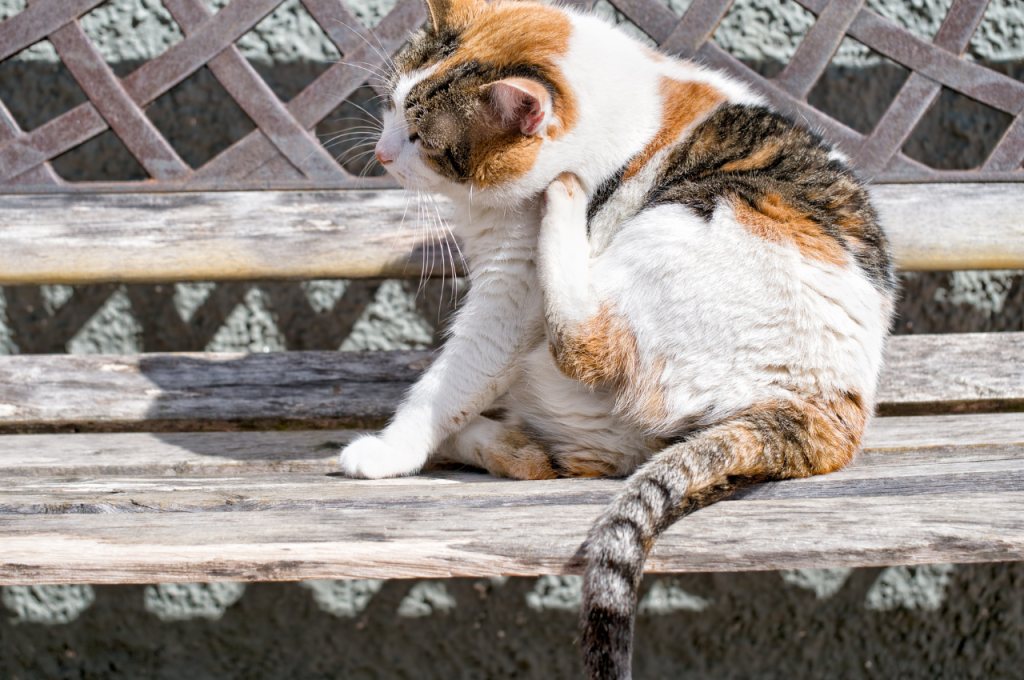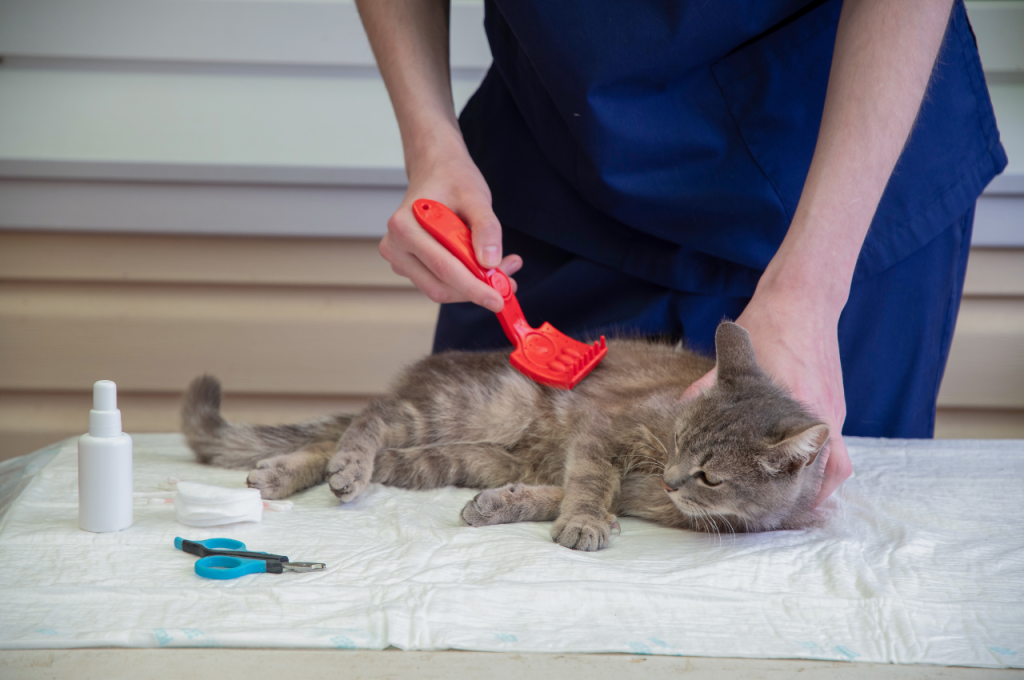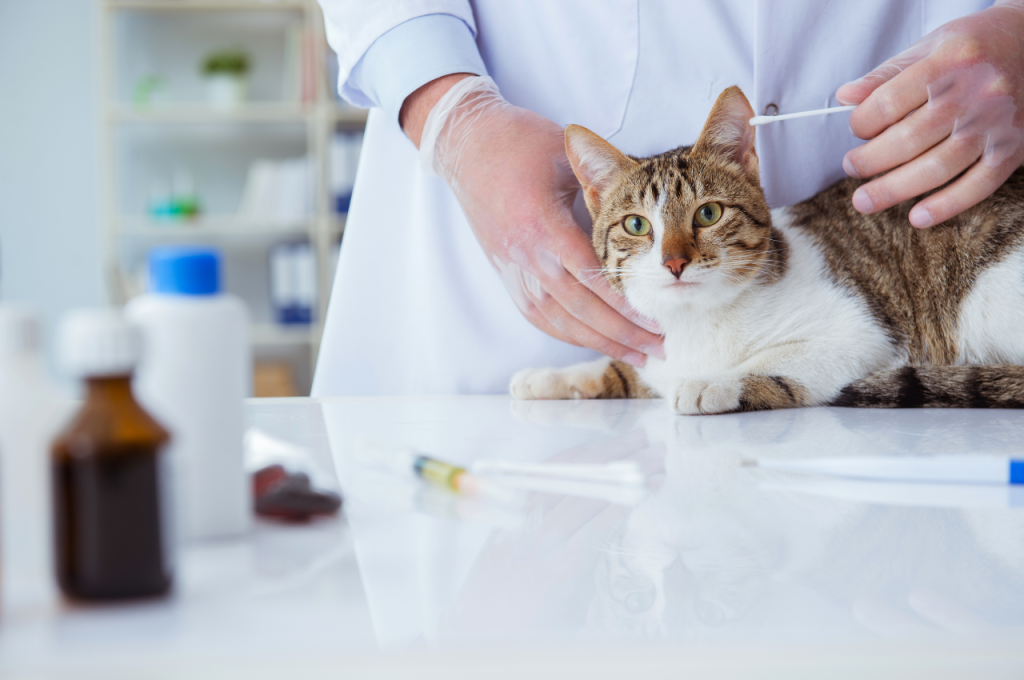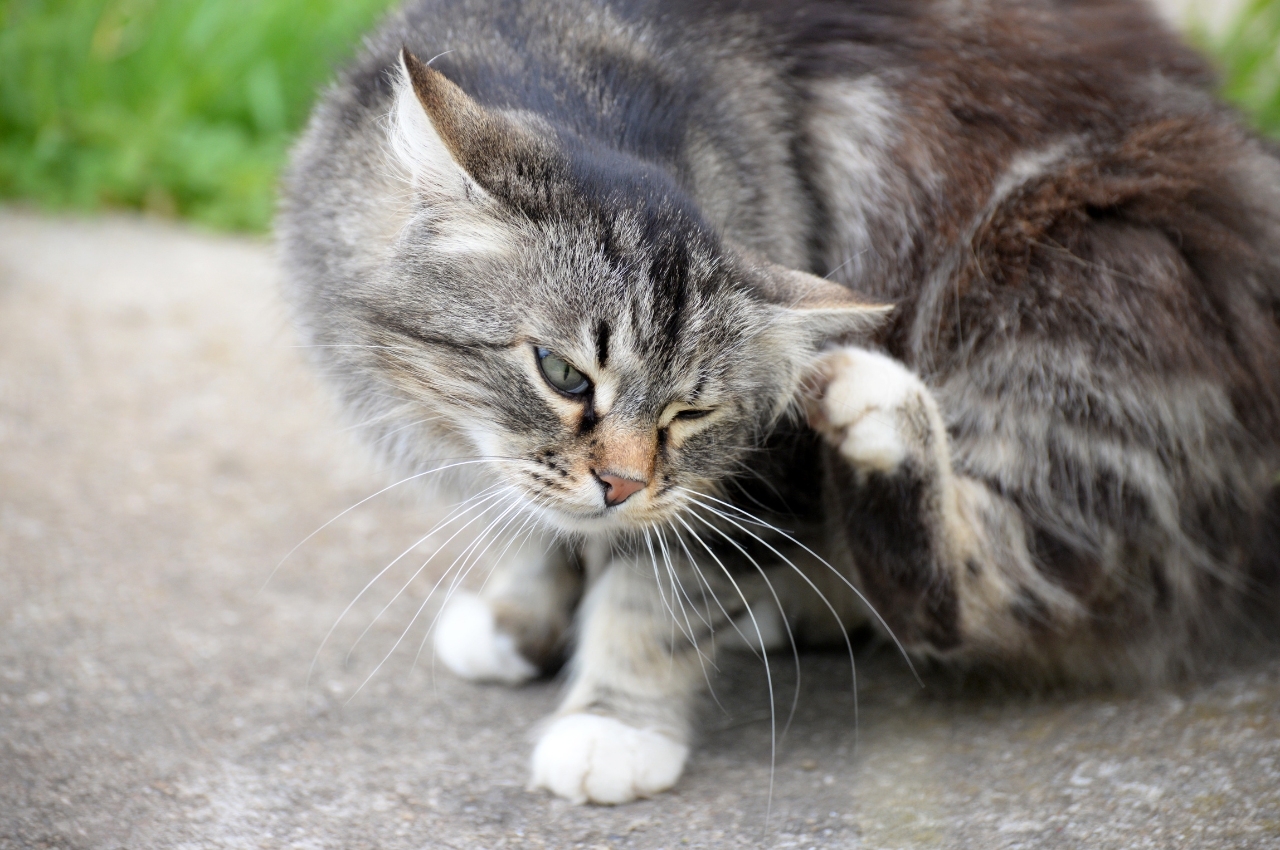To get rid of cat fleas, use a vet-approved flea treatment and regularly groom and vacuum your home. Cat fleas can be a nuisance, causing discomfort to your pet and infesting your living space.
Fortunately, there are effective methods to eliminate these pests and prevent future infestations. By following a few simple steps, you can ensure a flea-free environment for both your cat and your household. Let’s explore some practical and safe ways to tackle cat fleas and maintain a healthy, happy home for you and your feline companion.
The Flea Menace in Feline Friends
Cat fleas can be a pesky problem for feline friends. To get rid of cat fleas effectively, use flea treatments recommended by your vet and regularly clean your cat’s bedding and living areas. Vacuuming and washing your cat with flea shampoo can also help eliminate these annoying pests.

Cats are adorable pets that can make any house feel like home. However, they are also prone to attracting fleas, which can be a nightmare to deal with. Fleas are tiny insects that feed on your cat’s blood, causing itchiness, redness, and even infections. They can also make your furry friend restless, irritable, and anxious. To make matters worse, fleas can quickly multiply and infest your home, making it difficult to get rid of them. In this post, we will discuss how to identify and get rid of cat fleas.
Identifying a Flea Infestation
One of the first signs of a flea infestation is excessive scratching and biting by your cat. Fleas are tiny and can be difficult to spot, but you may notice small, dark brown specks on your cat’s fur, which are actually flea droppings. You may also find flea eggs, which are white and oval-shaped, on your cat’s bedding or around your home.
Life Cycle of Cat Fleas
Understanding the life cycle of cat fleas is crucial in getting rid of them. The life cycle consists of four stages: egg, larva, pupa, and adult. Female fleas lay eggs on your cat’s fur, and the eggs fall off onto the ground, carpets, or furniture. The eggs hatch into larvae, which feed on organic matter such as flea droppings. The larvae then spin cocoons and turn into pupae. The pupae can remain dormant for months until they sense the presence of a host, such as your cat, and emerge as adult fleas.
Getting Rid of Cat Fleas
To get rid of cat fleas, you need to treat your cat, your home, and your yard. There are several flea treatments available for cats, including spot-on treatments, oral medications, and flea collars. It’s essential to follow the instructions carefully and use the right dosage for your cat’s weight and age. You also need to vacuum your home thoroughly, especially carpets, furniture, and bedding, to remove flea eggs, larvae, and pupae. You can use flea sprays or powders on carpets and furniture, but make sure they are safe for pets.
Lastly, you need to treat your yard with flea repellents or insecticides to prevent re-infestation. In conclusion, cat fleas can be a nuisance, but with the right treatment and prevention methods, you can get rid of them. It’s crucial to identify a flea infestation early and take prompt action to prevent it from spreading. Remember to consult your vet before using any flea treatment on your cat, and always follow the instructions carefully.
Initial Steps Toward a Flea-free Pet
Taking the first steps towards a flea-free pet involves a few key measures. Start by regularly combing your cat’s fur, using a flea comb to catch and remove any fleas. Additionally, keep your home clean and vacuumed, paying close attention to areas where your cat spends time to eliminate any potential flea eggs or larvae.
Initial Steps Toward a Flea-Free Pet Fleas are a common problem for cat owners, and it’s important to take action as soon as you notice them. The initial steps toward a flea-free pet involve quarantining the infected cat, using combing and bathing techniques, and treating your home and yard for fleas. In this blog post, we’ll focus on the first step:
Quarantining the Infected Cat:
Quarantining your cat is an important first step to prevent the spread of fleas to other pets and areas of your home. Here’s how to do it:
- Choose a room for your cat that’s easy to clean and has no carpeting.
- Remove any bedding, toys, or litter boxes from the room.
- Use a flea comb to remove any fleas and eggs from your cat’s fur. Dispose of the fleas and eggs in a plastic bag.
- Bathe your cat using a flea shampoo. Be sure to follow the instructions on the label.
- Dry your cat with a towel and comb their fur again to remove any remaining fleas.
- Apply a flea treatment to your cat.
There are several options available, including topical treatments, oral medications, and flea collars. Consult with your veterinarian to determine the best option for your cat.
Combing and Bathing Techniques:
Combing and bathing your cat regularly can help prevent fleas from becoming a problem. Here are some tips:
- Use a flea comb to remove any fleas and eggs from your cat’s fur. Start at the head and work your way down to the tail.
- Dip the comb in a bowl of soapy water after each stroke to kill any fleas and eggs.
- Bathe your cat using a flea shampoo. Be sure to follow the instructions on the label.
- Rinse your cat thoroughly and dry them with a towel. Use a flea comb again to remove any remaining fleas.
In conclusion, taking these initial steps toward a flea-free pet can help prevent a flea infestation from becoming a major problem. By quarantining your cat, using combing and bathing techniques, and treating your home and yard for fleas, you can keep your cat and your home flea-free.
Natural Remedies to Combat Fleas
Fleas can be a nuisance for both cats and their owners. While there are various commercial products available to tackle this problem, some people prefer natural remedies to combat fleas. These alternatives are often safe, effective, and environmentally friendly. In this section, we will explore two natural solutions: herbal infusions and essential oils, as well as diatomaceous earth for flea control.
Herbal Infusions and Essential Oils
Herbal infusions and essential oils can be powerful tools in the fight against fleas. Certain plants, such as lavender, rosemary, and peppermint, have natural properties that repel these pesky insects. By creating homemade herbal infusions or using essential oils, you can harness the repellent qualities of these plants to keep fleas at bay.
Here are a few ways you can utilize herbal infusions and essential oils:
- Create a herbal flea spray by steeping dried herbs in boiling water, and then straining the liquid into a spray bottle. Add a few drops of essential oil for added potency. Spray this mixture on your cat’s fur, focusing on areas where fleas are commonly found.
- Make an herbal flea collar by soaking a fabric collar in a mixture of diluted essential oil and water. Allow it to dry before placing it on your cat. The scent of the essential oil will repel fleas and help protect your feline friend.
- Apply a few drops of diluted essential oil directly to your cat’s collar or bedding. This will create a flea-repellent environment and keep your cat comfortable and flea-free.
Diatomaceous Earth for Flea Control
Diatomaceous earth is a fine powder made from fossilized remains of diatoms, a type of algae. It is a natural and non-toxic substance that can effectively control fleas. The microscopic sharp edges of diatomaceous earth particles damage the fleas’ exoskeleton, leading to dehydration and ultimately their demise.
Here’s how you can use diatomaceous earth for flea control:
- Thoroughly vacuum your home, paying special attention to areas where your cat spends most of its time.
- Apply a light dusting of food-grade diatomaceous earth to carpets, upholstery, and other areas where fleas may be present. Leave it for a few hours or overnight.
- Afterward, vacuum the treated areas again to remove any dead fleas and diatomaceous earth residue.
It’s important to note that while diatomaceous earth is safe for cats and humans, it should be food-grade and not the kind used for pool filtration. By incorporating herbal infusions, essential oils, and diatomaceous earth into your flea-fighting routine, you can naturally combat fleas and provide relief for your cat. Remember to consult with your veterinarian before using any natural remedies, especially if your cat has any underlying health conditions.
Chemical Arsenal Against Fleas
When battling stubborn cat fleas, sometimes chemical treatments are necessary to effectively eradicate the infestation. These treatments come in various forms, each targeting different stages of the flea life cycle.

Topical Treatments and Spot-on
Topical treatments and spot-ons are popular choices among pet owners for their ease of use and effectiveness. These products are applied directly to the cat’s skin, usually between the shoulder blades, and work by killing adult fleas on contact.
- Easy to apply and long-lasting
- Effective in killing adult fleas
- Some products also target flea eggs and larvae
Oral Flea Control Medications
Oral flea control medications are another option for combating fleas in cats. These medications come in the form of pills or chews and work by disrupting the flea life cycle to prevent future infestations.
- Convenient and easy to administer
- Effective in preventing flea infestations
- Some medications also treat other parasites
Strategic House Cleaning to Eradicate Fleas
Strategic house cleaning is an essential component of eradicating cat fleas from your home. Taking a systematic approach to cleaning can help eliminate both adult fleas and their eggs, disrupting their life cycle and preventing infestations. By focusing on key areas such as vacuuming and pet bedding maintenance, you can effectively tackle the presence of fleas in your living space.
Vacuuming Strategies
Regular vacuuming is crucial in the fight against cat fleas. Use a vacuum with strong suction power to thoroughly clean carpets, rugs, and upholstered furniture where fleas and their eggs may be present. Pay particular attention to areas where your cat spends a lot of time, as these are likely hotspots for flea activity. Empty the vacuum bag or canister regularly to prevent fleas from re-infesting your home.
Washing and Maintenance of Pet Bedding
Wash your cat’s bedding and any other fabric items they frequently come into contact with, such as blankets or cushions, in hot water to kill fleas and their eggs. Regularly launder these items to prevent flea populations from establishing themselves in your home. Consider using a flea treatment product specifically designed for pet bedding to provide an additional layer of protection.
Innovative Flea Traps and Barriers
Innovative flea traps and barriers are effective methods for getting rid of cat fleas. These products work by attracting and trapping fleas, preventing them from infesting your home. With these solutions, you can keep your feline friend flea-free and your home clean.
Innovative Flea Traps and Barriers are effective tools for controlling and preventing cat flea infestations in your home. DIY Flea Traps are a budget-friendly and eco-friendly way to capture and eliminate fleas, while Preventive Barriers in Your Home can help stop fleas from entering living spaces. Let’s explore these innovative solutions in detail. DIY Flea Traps DIY flea traps are simple to make and can help reduce the number of fleas in your home.
You can create a homemade flea trap using common household items such as dish soap and water. The soapy water in the trap acts as a sticky barrier, capturing fleas as they jump in. Placing these traps in areas where your cat spends time can help control the flea population. Preventive Barriers in Your Home Implementing preventive barriers in your home is crucial for keeping fleas at bay. Start by regularly vacuuming carpets, furniture, and pet bedding to remove flea eggs and larvae.
Additionally, using flea collars, spot-on treatments, or oral medications for your cat can provide a preventive barrier against fleas. Keep your outdoor environment well-maintained to prevent fleas from entering your home. Innovative flea traps and preventive barriers are essential components of a comprehensive flea control strategy. By utilizing these methods, you can effectively combat flea infestations and create a comfortable environment for both you and your feline companion.
Professional Pest Control for Severe Infestations
When to Call The Professionals
If your home is suffering from a severe cat flea infestation, it may be time to seek the assistance of professional pest control services. Persistent infestations that do not respond to over-the-counter treatments or home remedies can be a sign that the problem is beyond your ability to manage effectively. Additionally, if members of your household are experiencing allergic reactions or if your pets are constantly scratching and uncomfortable, it’s crucial to bring in professional help to address the situation.
What to Expect From a Pest Control Visit
During a professional pest control visit for cat flea infestations, the technician will conduct a thorough inspection of your home to identify the extent of the infestation and locate the areas where fleas are most prevalent. They will then develop a targeted treatment plan to eradicate the fleas. This plan may involve the use of specialized insecticides, as well as recommendations for ongoing flea prevention to ensure that the infestation does not recur.
Moreover, they will provide guidance on preparing your home for treatment and may offer advice on how to care for your pets during and after the extermination process.
Preventive Measures to Keep Fleas at Bay
Preventive measures are crucial in keeping cat fleas at bay. By taking proactive steps to prevent fleas from infesting your furry friend and your home, you can maintain a healthy and comfortable environment for both you and your pet. Let’s explore some effective preventive measures that can help you keep fleas away from your beloved feline companion.
Regular Pet Grooming
Grooming your cat on a regular basis is essential for preventing fleas from taking up residence on your pet. Brushing your cat’s fur not only helps to remove any existing fleas and their eggs but also allows you to detect the presence of fleas at an early stage. Regular bathing with a flea shampoo can also help in keeping the fleas away. Additionally, keeping your cat’s fur trimmed can make it more difficult for fleas to hide and lay eggs, reducing the risk of infestation.
Environmental Controls for Flea Prevention
Implementing environmental controls is crucial in preventing fleas from thriving in your home. Regularly vacuuming your home, especially areas where your cat spends a lot of time, can help in removing flea eggs and larvae. Washing your pet’s bedding and any other areas they frequent in hot water can also help in eliminating fleas at various stages of their life cycle. Using natural flea repellents such as cedar chips or diatomaceous earth in your home can provide an additional layer of defense against fleas.
Understanding Flea Control Products
Understanding flea control products is essential for getting rid of cat fleas. Effective flea control products include oral medications, topical treatments, flea collars, and flea sprays. It’s important to choose the right product for your cat’s needs and to follow the instructions carefully to ensure success in eliminating fleas.
Safety and Efficacy
Safety and efficacy are paramount when selecting a flea control product for your cat. Look for natural ingredients, as they are generally safer for your pet and the environment. Always read the labels carefully to ensure the product is specifically formulated for cats. Consult your veterinarian to determine the best option for your cat’s individual needs.
Choosing The Right Product for Your Cat
When choosing a flea control product for your cat, consider their age, weight, and any existing health conditions. Topical treatments are convenient and effective, while oral medications provide systemic protection. Flea collars offer continuous protection and are suitable for cats who dislike topical treatments. Ensure you select a product that targets both adult fleas and their eggs to effectively break the flea life cycle.
In conclusion, understanding the safety, efficacy, and suitability of flea control products is essential for combating cat flea infestations. By prioritizing these factors, you can effectively protect your cat from these pesky parasites.
Monitoring and Maintaining a Flea-free Environment
Maintaining a flea-free environment is essential for cat owners looking to get rid of cat fleas. By regularly monitoring and taking necessary steps, such as vacuuming, washing bedding, and treating the cat with appropriate flea control products, it is possible to create a pest-free space for both the cat and the household.

Regular Check-ups
Regular check-ups are essential for keeping your cat flea-free. During veterinary visits, your vet can recommend effective treatments and preventive measures on how to get rid of cat fleas. They can also check for signs of flea infestations, such as excessive scratching or skin irritation. Regular flea control products, combined with maintaining a clean living environment, are crucial. Consistent monitoring and timely interventions ensure your cat stays healthy and comfortable, free from the discomfort and health risks associated with fleas.
Long-term Strategies for Flea Prevention
Long-term strategies for flea prevention are vital to your cat’s health. To understand how to get rid of cat fleas, use regular flea treatments and maintain a clean environment. Vacuum frequently, wash your cat’s bedding, and treat outdoor areas if your cat goes outside. Regular vet check-ups ensure early detection and treatment. Combining these measures will help keep your cat flea-free and comfortable, preventing infestations and associated health issues.
Conclusion
To effectively eliminate cat fleas, consistency is key. Regular grooming, vacuuming, and treatment are vital. Remember, prevention is better than cure. Keep your cat and home clean to avoid future infestations. By following these steps, you can create a flea-free environment for your feline friend.
